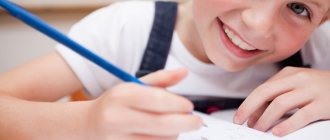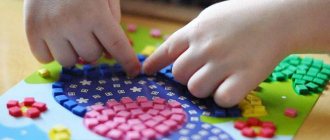Play with two- or three-layer insert frames (puzzles)
Multilayer frame inserts are simply amazing toys; they combine the functions of both a puzzle and a platform for a story game. As a rule, such inset frames show the child one object in different sections, for example, a house (bus, car) inside and outside. This representation of an object contributes to the development of the child’s imaginative thinking. And it’s just incredibly interesting! Even parents
For example, the puzzle “House of Hares” (My-shop, Read) consists of the following layers: on the lowest layer the bunnies woke up and got out of their beds (in this case, you can get each hare and play a small plot game with them), on the next layer the awakened hares have already begun to carry out some kind of activity: drinking tea, taking out toys, on the third layer the house is shown from the outside and you can see what the hares are doing on the street. Here are interesting options for two-layer puzzles - House or Bus.
In this game, the child learns to distinguish the details of each layer and combine them not just by the similarity of objects (as in ordinary frame inserts), but by meaning.
Simple educational games with clothespins
For these games you don't need anything other than the clothespins themselves. Well, or almost nothing.
Remove the bug from your clothes . Attach clothespins of different colors to yourself or your child and invite him to remove the bug. This is a fun game with which you can consolidate your knowledge of basic colors, body parts, clothing, and learn the concepts of “right” and “left” (right hand, left leg).
You can also run after dad together and save him from annoying bugs. Or run away from them yourself.
Find the bug . Ask your child to wait for you in another room, and you yourself attach clothespins to various objects - curtains, toys, furniture, etc. Tell your child that while he was away, bugs arrived and now they need to be caught and put in a box or bucket.
The game perfectly develops attention and is ideal for the first games, when the child’s fingers cannot yet attach clothespins.
This is a very fun game. Antoshka adores her. You can run, train your arms, and show off your catch. You can also count the caught bugs. This is how we play - we are looking for 7 bugs.
When the child’s fingers get stronger, invite him to plant bugs, and you will look for them. But my experience shows that children like the first version of the game more.
Drying clothes . Your child has probably seen you hanging out laundry after washing more than once. Children love to repeat after adults! If you tie a rope between the legs of the table or even the handles of the basin, with what joy the baby will hang out his socks or clothes for the dolls!
Beads from clothespins . Clothespins can be strung on a cord to make beautiful beads for mom. When the child can easily cope with the task, complicate the task and invite him to alternate clothespins of different colors.
Designer made from clothespins . Build a robot, an airplane, or a deer from clothespins. I’m currently assembling, and Antoshka is taking it apart.
We attach it to everything . Attach clothespins with your child to everything that comes to hand. Make earrings for a bear, decorate a hanger, plastic cups, a car, and designer parts.
Antoshka likes to attach clothespins around the perimeter of the box in which we store them. And if you cover the box with colored paper (each side has a different color), then this is another reason to repeat the primary colors.
Designer parts can be used for the same purposes .
Make a picture using puzzle cubes
If your child is already familiar with simple puzzles, now you can invite him to assemble a picture on puzzle cubes (of 4 parts) (Labyrinth, Ozon, My-shop). This task is a little more difficult, because here, before placing the cube in the right place, the child must also turn it and find the appropriate side. At first, of course, you will have to twist the cube to find the right side, but while you are doing this, explain to your baby why you chose one side or another.
Use a sponge to pour water from one bowl to another
The game is in many ways similar to the previous one, but still gives the child slightly different sensations. A few tips: firstly, place a bowl of water on the left and an empty bowl on the right , then the child will pour water from left to right, this direction of action is important for placing his hand before writing. Secondly, it should be noted that it is more convenient to play with a sponge that is completely soft (without a hard part); if you were unable to buy a soft sponge, then cut off the hard part with a knife.
Build paths from dominoes
This may seem surprising to some, but a one-year-old child can already play dominoes! Of course, while there is no need to explain detailed rules to the child, tell him what a “bazaar” and “fish” are, he is unlikely to be interested in this. But the domino principle itself, based on the selection of identical pictures, can easily be grasped by a child.
To play, you will need a children's domino with pictures that the baby can understand (for example, we have this, other options are Ozon, My-shop). Explain to your child that you can build paths (or fences, as you prefer) from dominoes. But the paths are not simple: the dominoes in them must be selected so that the pictures on the edges match. Taisiya and I used dominoes to build a large fence, inside of which some animal would definitely live. Tasya could play dominoes on her own for a long time.
Cut with scissors
After 1 year 9 months, the child’s motor skills become more and more perfect, and you can already begin to introduce the child to scissors. Surely you have already heard about the famous Kumon notebooks (Labyrinth, Ozon, My-shop), which can teach any child how to cut, but if the child has never worked with scissors before, do not rush to immediately purchase notebooks and complete tasks. At the first stage, your main task is to teach your child to hold scissors correctly, open and close them, and simply introduce the child to the process of cutting paper into pieces.
First, let your child learn to make short cuts along the edge of the sheet. And only then, when his actions are more confident, offer to make several cuts in succession along the drawn line. So, before class, you can draw a few not too long lines on a small sheet of paper and invite your child to cut the sheet along these lines.
Naturally, for classes you need to purchase special children's scissors with blunt ends and it is advisable that the scissors have one ring small and the other larger. The thumb must be inserted into the small hole of the scissors, and the index and middle finger into the large one . If it is more convenient for the baby, you can also insert your ring finger into the large hole. It is also important to teach the child to correctly hold the sheet with his left hand (if the child is right-handed).
A little later, you can move on to Kumon notebooks; the unusual tasks in them stimulate the child’s interest. Taisiya, for example, developed a passion for Kumon tasks at the age of 2 years and 2 months. In parallel with the use of notebooks, you can continue to draw lines on paper, gradually complicating them: adding zigzags, waves, etc.
DIY games with clothespins
For these games you will need colored cardboard and a minimum of time. It takes a couple of minutes to cut the blank, but it will last a long time.
Using clothespins, we attach rays to the sun , rain to a cloud , and plant grass in the garden bed .
We make branches for the Christmas tree , tops for carrots and turnips , and thorns for the hedgehog . Since I'm not much of an artist, I chose to print the hedgehog.
Making ears for bunnies .
This is what we do. There are more than enough such games. But you can come up with many other options : attaching legs and arms to little people, fingers to palms, paws to bugs, petals to flowers, legs to animals, wings to an airplane, leaves to a tree, etc.
And you can create three-dimensional objects by attaching, for example, legs to a table .
Multicolored circle . Another of our favorite games. Its creation will take a little more time, but the results will please you.
I cut a circle out of cardboard, divided it into 6 parts, and colored each part to match the colors of the clothespins I had. I drew circles along the outer edge: from two to five. Antoshka attaches clothespins of the corresponding color according to the number of circles. The game is well suited for children learning to count.
We feed the chick . Meet Gosha, the always hungry chick. Mommy clothespin feeds him worms. And Antoshka helps her.
It’s easy to make such a chick; in the future it can be used not only for playing with clothespins. We cut out a beak in the lid of the jar, glued the eyes, crest and wings to double-sided tape. We use hair bands, cut laces, etc. as bugs and worms.
Pour water with a pipette or bulb
Another activity to develop your child's finger strength and fine motor skills. The essence of the lesson is this: you need to pour water from one container to another using a rubber bulb (syringe), a culinary dispenser (as in the photo) or a pipette. The containers can be anything, however, it seems to me that using an ice mold makes the game much more interesting. So, Taisiya and I take water in a small bowl and fill some cells of the form, then we check which cells are empty and which are full, if desired, we count how many cells are filled. Then collect the liquid from the cells back into the bowl.
The most difficult thing for a child in this game is to learn the sequence of actions: first we press on the bulb, then we lower the tip into the water, we collect water, then, without pressing, we transfer it to another container, etc. At first, hold the child’s hand in yours and act together, so the baby will better understand the essence.
Now there are very cute pipettes on sale from Learning Research, they are great for a child's hand. Available in the KoroBoom store.
Try not to pour a lot of water for the game, pour as much as you and your baby can pour back and forth in one game. If you are using a small medicine dropper, the containers should also be very small. If desired, the water can be colored with food coloring.
Yes, and remember that you need to pour water before playing, as well as clean up your work area together with your baby; you can read more about this in the article about development using the Montessori method.









